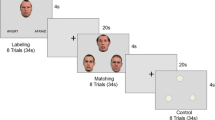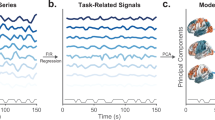Abstract
The neurobiological mechanisms that underlie facial affect recognition deficits after traumatic brain injury (TBI) have not yet been identified. Using functional magnetic resonance imaging (fMRI), study aims were to 1) determine if there are differences in brain activation during facial affect processing in people with TBI who have facial affect recognition impairments (TBI-I) relative to people with TBI and healthy controls who do not have facial affect recognition impairments (TBI-N and HC, respectively); and 2) identify relationships between neural activity and facial affect recognition performance. A facial affect recognition screening task performed outside the scanner was used to determine group classification; TBI patients who performed greater than one standard deviation below normal performance scores were classified as TBI-I, while TBI patients with normal scores were classified as TBI-N. An fMRI facial recognition paradigm was then performed within the 3T environment. Results from 35 participants are reported (TBI-I = 11, TBI-N = 12, and HC = 12). For the fMRI task, TBI-I and TBI-N groups scored significantly lower than the HC group. Blood oxygenation level-dependent (BOLD) signals for facial affect recognition compared to a baseline condition of viewing a scrambled face, revealed lower neural activation in the right fusiform gyrus (FG) in the TBI-I group than the HC group. Right fusiform gyrus activity correlated with accuracy on the facial affect recognition tasks (both within and outside the scanner). Decreased FG activity suggests facial affect recognition deficits after TBI may be the result of impaired holistic face processing. Future directions and clinical implications are discussed.



Similar content being viewed by others
References
Adolphs, R. (2002). Recognizing emotion from facial expressions: psychological and neurological mechanisms. Behavioral and Cognitive Neuroscience Reviews, 1(1), 21.
Adolphs, R., Gosselin, F., Buchanan, T. W., Tranel, D., Schyns, P., & Damasio, A. R. (2005). A mechanism for impaired fear recognition after amygdala damage. Nature, 433(7021), 68–72.
Avidan, G., Tanzer, M., & Behrmann, M. (2011). Impaired holistic processing in congenital prosopagnosia. Neuropsychologia, 49(9), 2541–2552.
Babbage, D. R., Yim, J., Zupan, B., Neumann, D., Tomita, M. R., & Willer, B. (2011). Meta-analysis of facial affect recognition difficulties after traumatic brain injury. Neuropsychology, 25(3), 277.
Bornhofen, C., & McDonald, S. (2008). Comparing strategies for treating emotion perception deficits in traumatic brain injury. The Journal of Head Trauma Rehabilitation, 23(2), 103–115.
Bourke, C., Douglas, K., & Porter, R. (2010). Processing of facial emotion expression in major depression: a review. Australian and New Zealand Journal of Psychiatry, 44(8), 681–696.
Busigny, T., Joubert, S., Felician, O., Ceccaldi, M., & Rossion, B. (2010). Holistic perception of the individual face is specific and necessary: evidence from an extensive case study of acquired prosopagnosia. Neuropsychologia, 48(14), 4057–4092.
Busigny, T., Van Belle, G., Jemel, B., Hosein, A., Joubert, S., & Rossion, B. (2014). Face-specific impairment in holistic perception following focal lesion of the right anterior temporal lobe. Neuropsychologia, 56, 312–333.
Centers for Disease Control and Prevention. http://www.cdc.gov/TraumaticBrainInjury/index.html. Last Accessed January 23, 2015.
Curran, C. A., Ponsford, J. L., & Crowe, S. (2000). Coping strategies and emotional outcome following traumatic brain injury: a comparison with orthopedic patients. The Journal of Head Trauma Rehabilitation, 15(6), 1256–1274.
Dalton, K. M., Nacewicz, B. M., Johnstone, T., Schaefer, H. S., Gernsbacher, M. A., Goldsmith, H., et al. (2005). Gaze fixation and the neural circuitry of face processing in autism. Nature Neuroscience, 8(4), 519–526.
Dolan, R. J., Morris, J. S., & de Gelder, B. (2001). Crossmodal binding of fear in voice and face. Proceedings of the National Academy of Sciences, 98(17), 10006–10010.
Edwards, J., Jackson, H. J., & Pattison, P. E. (2002). Emotion recognition via facial expression and affective prosody in schizophrenia: a methodological review. Clinical Psychology Review, 22(6), 789–832.
Fann, J. R., Bombardier, C. H., Dikmen, S., Esselman, P., Warms, C. A., Pelzer, E., et al. (2005). Validity of the patient health questionnaire-9 in assessing depression following traumatic brain injury. The Journal of Head Trauma Rehabilitation, 20(6), 501–511.
Fusar-Poli, P., Placentino, A., Carletti, F., Landi, P., Allen, P., Surguladze, S., et al. (2009). Functional atlas of emotional faces processing: a voxel-based meta-analysis of 105 functional magnetic resonance imaging studies. Journal of Psychiatry & Neuroscience, 34(6), 418.
Ganel, T., Valyear, K. F., Goshen-Gottstein, Y., & Goodale, M. A. (2005). The involvement of the “fusiform face area” in processing facial expression. Neuropsychologia, 43(11), 1645–1654.
Gur, R. C., Sara, R., Hagendoorn, M., Marom, O., Hughett, P., Macy, L., et al. (2002a). A method for obtaining 3-dimensional facial expressions and its standardization for use in neurocognitive studies. Journal of Neuroscience Methods, 115(2), 137–143.
Gur, R. E., McGrath, C., Chan, R. M., Schroeder, L., Turner, T., Turetsky, B. I., et al. (2002b). An fMRI study of facial emotion processing in patients with schizophrenia. The American Journal of Psychiatry, 159(12), 1992–1999.
Harms, M. B., Martin, A., & Wallace, G. L. (2010). Facial emotion recognition in autism spectrum disorders: a review of behavioral and neuroimaging studies. Neuropsychology Review, 20(3), 290–322.
Kanwisher, N., & Yovel, G. (2006). The fusiform face area: a cortical region specialized for the perception of faces. Philosophical Transactions of the Royal Society, B: Biological Sciences, 361(1476), 2109–2128.
Klin, A., Jones, W., Schultz, R., Volkmar, F., & Cohen, D. (2002). Visual fixation patterns during viewing of naturalistic social situations as predictors of social competence in individuals with autism. Archives of General Psychiatry, 59(9), 809–816.
Knox, L. A., & Douglas, J. (2009). Long-term ability to interpret facial expression after traumatic brain injury and its relation to social integration. Brain and Cognition, 69, 442–449.
Kroenke, K., Spitzer, R. L., & Williams, J. B. W. (2001). The PHQ-9. Journal of General Internal Medicine, 16(9), 606–613.
Li, H., Chan, R. C., McAlonan, G. M., & Gong, Q.-Y. (2010). Facial emotion processing in schizophrenia: a meta-analysis of functional neuroimaging data. Schizophrenia Bulletin, 36(5), 1029–1039.
Marsh, N., Kersel, D., Havill, J., & Sleigh, J. (1998). Caregiver burden at 6 months following severe traumatic brain injury. Brain Injury, 12(3), 225–238.
Maurer, D., Le Grand, R., & Mondloch, C. J. (2002). The many faces of configural processing. Trends in Cognitive Sciences, 6(6), 255–260.
McIntire, K. A., Danforth, M. M., Schneider, H. G. (1997). Measuring cue perception: Assessment of reliability and validity. Paper presented at the Meeting of the Southeastern Psychological Association, Atlanta, GA.
Narumoto, J., Okada, T., Sadato, N., Fukui, K., & Yonekura, Y. (2001). Attention to emotion modulates fMRI activity in human right superior temporal sulcus. Cognitive Brain Research, 12(2), 225–231.
Neumann, D., Zupan, B., Babbage, D. R., Radnovich, A. J., Tomita, M., Hammond, F., et al. (2012). Affect recognition, empathy, and dysosmia after traumatic brain injury. Archives of Physical Medicine and Rehabilitation, 93(8), 1414–1420.
Neumann, D., Keiski, M. A., McDonald, B. C., & Wang, Y. (2014a). Neuroimaging and facial affect processing: implications for traumatic brain injury. Brain Imaging and Behavior, 8(3), 460–473.
Neumann, D., Zupan, B., Malec, J. F., & Hammond, F. (2014b). Relationships between alexithymia, affect recognition, and empathy after traumatic brain injury. The Journal of Head Trauma Rehabilitation, 29(1), E18–E27.
Neumann, D., Babbage, D. R., Zupan, B., & Willer, B. (2015). A randomized controlled trial of emotion recognition training after traumatic brain injury. The Journal of Head Trauma Rehabilitation, 30(3), E12–E23.
Nowicki, S., & Duke, M. P. (1994). Individual differences in the nonverbal communication of affect: the diagnostic analysis of nonverbal accuracy scale. Journal of Nonverbal Behavior, 18(1), 9–35.
Nowicki, S., & Mitchell, J. (1998). Accuracy in identifying affect in child and adult faces and voices and social competence in preschool children. Genetic, Social, and General Psychology Monographs, 124(1), 39–59.
Ogai, M., Matsumoto, H., Suzuki, K., Ozawa, F., Fukuda, R., Uchiyama, I., et al. (2003). fMRI study of recognition of facial expressions in high-functioning autistic patients. Neuroreport, 14(4), 559–563.
Pelphrey, K. A., Sasson, N. J., Reznick, J. S., Paul, G., Goldman, B. D., & Piven, J. (2002). Visual scanning of faces in autism. Journal of Autism and Developmental Disorders, 32(4), 249–261.
Phillips, M. L., Drevets, W. C., Rauch, S. L., & Lane, R. (2003). Neurobiology of emotion perception I: the neural basis of normal emotion perception. Biological Psychiatry, 54(5), 504–514.
Piggot, J., Kwon, H., Mobbs, D., Blasey, C., Lotspeich, L., Menon, V., et al. (2004). Emotional attribution in high-functioning individuals with autistic spectrum disorder: a functional imaging study. Journal of the American Academy of Child and Adolescent Psychiatry, 43(4), 473–480.
Rossion, B. (2013). The composite face illusion: a whole window into our understanding of holistic face perception. Visual Cognition, 21(2), 139–253.
Rossion, B., & Gauthier, I. (2002). How does the brain process upright and inverted faces? Behavioral and Cognitive Neuroscience Reviews, 1(1), 63–75.
Sabatinelli, D., Fortune, E. E., Li, Q., Siddiqui, A., Krafft, C., Oliver, W. T., et al. (2011). Emotional perception: meta-analyses of face and natural scene processing. NeuroImage, 54(3), 2524–2533.
Schiltz, C., Dricot, L., Goebel, R., & Rossion, B. (2010). Holistic perception of individual faces in the right middle fusiform gyrus as evidenced by the composite face illusion. Journal of Vision, 10(2), 25.
Spell, L. A., & Frank, E. (2000). Recognition of nonverbal communication of affect following traumatic brain injury. Journal of Nonverbal Behavior, 24(4), 285–300.
Spielberger, C. D., Gorsuch, R. L., & Lushene, R. E. (1970). Manual for the state-trait anxiety inventory. Palo Alto: Consulting Psychologists Press.
Spielberger, C. D., Reheiser, E. C., Ritterband, L. M., Sydeman, S. J., & Unger, K. K. (1995). In J. N. Butcher (Ed.), Assessment of emotional states and personality traits: Measuring psychological vital signs, clinical personality assessment: Practical approaches. New York: Oxford University Press.
Spikman, J. M., Milders, M. V., Visser-Keizer, A. C., Westerhof-Evers, H. J., Herben-Dekker, M., & van der Naalt, J. (2013). Deficits in facial emotion recognition indicate behavioral changes and impaired self-awareness after moderate to severe traumatic brain injury. PLoS One, 8(6), e65581.
Vassallo, S., Cooper, S. L., & Douglas, J. M. (2009). Visual scanning in the recognition of facial affect: is there an observer sex difference? Journal of Vision, 9(3), 11.
Wang, A. T., Dapretto, M., Hariri, A. R., Sigman, M., & Bookheimer, S. Y. (2004). Neural correlates of facial affect processing in children and adolescents with autism spectrum disorder. Journal of the American Academy of Child and Adolescent Psychiatry, 43(4), 481–490.
Winston, J. S., Henson, R., Fine-Goulden, M. R., & Dolan, R. J. (2004). fMRI-adaptation reveals dissociable neural representations of identity and expression in face perception. Journal of Neurophysiology, 92(3), 1830–1839.
Yim, J., Babbage, D. R., Zupan, B., Neumann, D., & Willer, B. (2013). The relationship between facial affect recognition and cognitive functioning after traumatic brain injury. Brain Injury, 27(10), 1155–1161.
Acknowledgments
We would like to thank Dr. Ruben Gur and his colleagues for generously sharing their fMRI neuroimaging facial affect recognition task. This research was funded by the Indiana University Collaborative Research Grant fund of the Office of the Vice President for Research and by the Indiana University Signature Center: Brain Rehabilitation, Advanced Imaging, and Neuroscience.
Conflicts of interest
Dawn Neumann, Brenna C. McDonald, John West, Michelle A. Keiski, and Yang Wang declare that they have no conflicts of interest.
Compliance with ethical standards
All procedures followed were in accordance with the ethical standards of the Indiana University Institutional Review Board and with the Helsinki Declaration of 1964, and the applicable revisions at the time of the investigation. Informed consent was obtained from all participants for being included in the study.
Author information
Authors and Affiliations
Corresponding author
Rights and permissions
About this article
Cite this article
Neumann, D., McDonald, B.C., West, J. et al. Neurobiological mechanisms associated with facial affect recognition deficits after traumatic brain injury. Brain Imaging and Behavior 10, 569–580 (2016). https://doi.org/10.1007/s11682-015-9415-3
Published:
Issue Date:
DOI: https://doi.org/10.1007/s11682-015-9415-3




